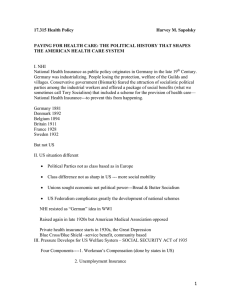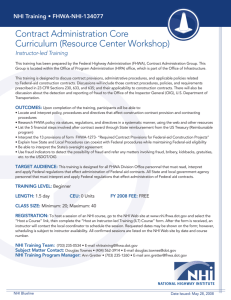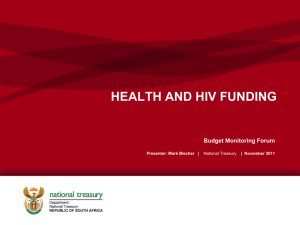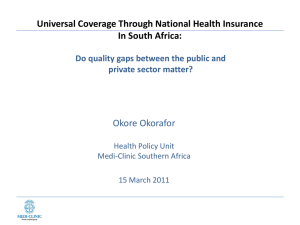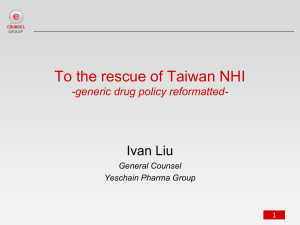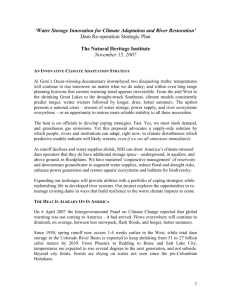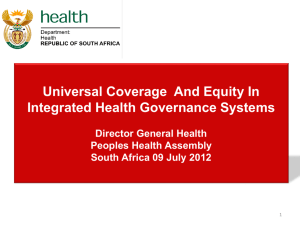Harold Wolpe 80th Memorial Lecture – 14 September 2009
advertisement
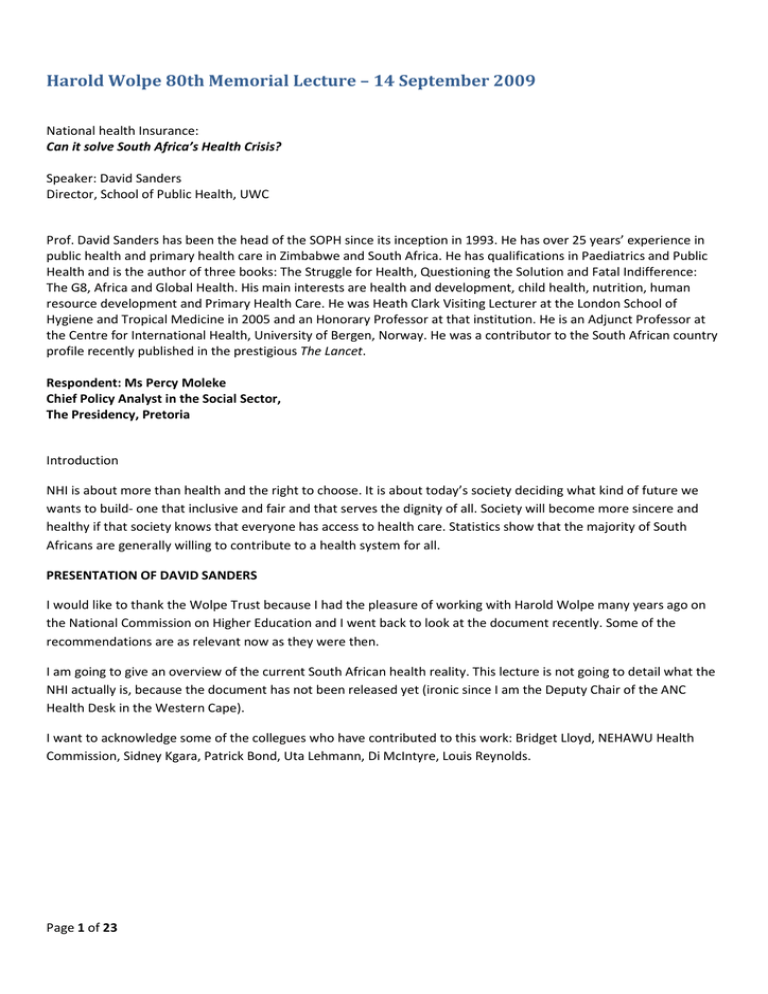
Harold Wolpe 80th Memorial Lecture – 14 September 2009 National health Insurance: Can it solve South Africa’s Health Crisis? Speaker: David Sanders Director, School of Public Health, UWC Prof. David Sanders has been the head of the SOPH since its inception in 1993. He has over 25 years’ experience in public health and primary health care in Zimbabwe and South Africa. He has qualifications in Paediatrics and Public Health and is the author of three books: The Struggle for Health, Questioning the Solution and Fatal Indifference: The G8, Africa and Global Health. His main interests are health and development, child health, nutrition, human resource development and Primary Health Care. He was Heath Clark Visiting Lecturer at the London School of Hygiene and Tropical Medicine in 2005 and an Honorary Professor at that institution. He is an Adjunct Professor at the Centre for International Health, University of Bergen, Norway. He was a contributor to the South African country profile recently published in the prestigious The Lancet. Respondent: Ms Percy Moleke Chief Policy Analyst in the Social Sector, The Presidency, Pretoria Introduction NHI is about more than health and the right to choose. It is about today’s society deciding what kind of future we wants to build- one that inclusive and fair and that serves the dignity of all. Society will become more sincere and healthy if that society knows that everyone has access to health care. Statistics show that the majority of South Africans are generally willing to contribute to a health system for all. PRESENTATION OF DAVID SANDERS I would like to thank the Wolpe Trust because I had the pleasure of working with Harold Wolpe many years ago on the National Commission on Higher Education and I went back to look at the document recently. Some of the recommendations are as relevant now as they were then. I am going to give an overview of the current South African health reality. This lecture is not going to detail what the NHI actually is, because the document has not been released yet (ironic since I am the Deputy Chair of the ANC Health Desk in the Western Cape). I want to acknowledge some of the collegues who have contributed to this work: Bridget Lloyd, NEHAWU Health Commission, Sidney Kgara, Patrick Bond, Uta Lehmann, Di McIntyre, Louis Reynolds. Page 1 of 23 Outline of the Presentation South Africa’s comparative performance in health Premature mortality – levels and causes Health policy and the health sector: advances and continuing challenges A major challenge to successful implementation of a NHI The health human resource situation Proposed skills mix for each level, including CHW’s and Mid level workers Proposed initiatives to address health challenges Slide on health indicators GDP Public per health capita expenditure (PPP US$) (% of GDP) One-yearolds Life Infant expectancy mortality at rate birth (per 1,000 (years) live births) fully immunized against Measles (%) 2002 2001 2002 1970-75 200005 1970 2002 Cuba 5,259 6.2 98 70.7 76.7 34 7 Brazil 7,770 3.2 93 59.5 68.1 95 30 Thailand 7,010 2.1 94 61 69.3 74 24 China 4,580 2 79 63.2 71 85 31 South Africa 10,070 3.6 78 53.7 47.7 .. 52 South Africa is per capita is richer than all of the above countries and our public expenditure is reasonably healthy but our results are very poor. See how life expectancy has dropped so dramatically. We have the dubious distinction of being one of four countries with an increasing infant child mortality rate. Page 2 of 23 How is SA doing on millennium development goal 4 Goal 4: Reduce child mortality Target 5: Reduce by two-thirds, between 1990 and 2015, the under-five mortality rate But, as you can see, we are moving away from that goal (see the last set of bars – which is our goal to achieve that Millennium Development Goal). IMR U5MR 100 90 80 70 60 50 40 30 20 10 0 1990 2000 Why is it this way? The main reason is the extent of inequality in South Africa. Page 3 of 23 Health inequalities in SA The Western Cape is the best performing province in terms of infant mortality, but if you look at Cape Town itself, the areas with the highest mortality are four times as high as other parts of the city (the worst performing areas are all poor – Khayelitsha, Nyanga and Guguletu). Causes AIDS is a big problem and we have seen this massive increase in death, especially in young women death. See the mortality increases, especially amongst young people. 0.012 0.01 RATE 0.008 1985 0.006 1995 1999/00 0.004 0.002 0 15-19 20-24 25-29 30-34 35-39 40-44 45-49 50-54 AGE But, HIV/Aids is not the only health crisis in South Africa Quadruple burden of disease pre-transitional diseases and poverty related conditions eg childhood under-nutrition and infections, maternal mortality emerging chronic diseases eg obesity, heart disease, diabetes injuries - including interpersonal violence HIV/AIDS and TB epidemics (TB cases increased from 109,000 in 1996 to 341,165 in 2006. 55% cases also have HIV) MRC Burden of Disease Unit, 2004 Interpersonal violence - this is the top cause of death in Cape Town of young males is violence and then only AIDS. Page 4 of 23 Risk Factors There are both upstream and downstream factors. Biological Behavioural Societal Structural Biological determinants (eg diet) in comparison to structural changes which are upstream (eg education) Income Inequalities GINI coefficient has .56 in 1995 and .73 in 2005, which makes us one of the most unequal societies in the world. Nutrition and Dietary Intake The National Food Consumption Survey (1999) showed that in a large national sample of children aged 1-3 45% received less than two-thirds of their daily energy requirements 80% received less than two-thirds of their daily iron requirements 65% received less than two-thirds of their daily Vitamin A requirements The National Food Consumption Survey (2005) showed: • 1 in 3 women and children are anaemic • 1 in 3 children and 1 in 4 women have Vit A deficiency • 45% of children are Zinc deficient (predisposes them to infection) Page 5 of 23 Fast food consumption and obesity On the other side of the spectrum, there is the massive growth in obesity in South Africa. Burger and chicken outlets have doubled as have the number of transactions. This information only concerns formal fast food and we know how many informal outlets there are at spaza shops and on the side of the road. Growing levels of obesity in SA and the problems associated with that are significant. Annual admission to outpatient at Red Cross Children’s Hospital Massive increase in diarrhea cases Why more and more sick children? These are the problems - decline of health staff, problems of morale, water and sanitation, increased load on hospitals from upstream factors. Page 6 of 23 National Health Plan 1994 Primary health care “the underlying philosophy for restructuring the health system is the primary health care approach, with emphasis on appropriate, comprehensive, promotive, preventive, rehabilitative and curative care provided by appropriate PHC facilities, with priority for PHC service in rural areas and poor urban areas…based on full community participation…” National Health Plan 1994 So, what has happened with this plan thus far? Selected Key Policy advances and implementation successes • Unification of separate health services – 14 different health services • Establishment of districts • Anti-smoking legislation – one of our best legislative interventions • Free health care for mothers and children • Choice on Termination of Pregnancy Bill • Notification of and enquiry into maternal deaths • Clinic building programme (1800 built) • Essential drugs list • Primary School Nutrition Programme • HIV/AIDS programmes expanded (PMTCT & ART) Challenges to our health system • Failure to address inequities between public and private sectors • Voluntary severance packages and downsizing of health workforce • Ringfenced funding of tertiary and academic care, relatively, but not primary • Grossly inadequate funding (until recently) of priority programmes e.g. HIV/TB • Failure to implement intersectoral approaches • Very slow transformation of training programmes • Increasing dominance of managerialism • Abandonment for 10 years of community health worker programmes Page 7 of 23 Expenditure Expenditure trends by function (real 2007/08 prices) 140,000 120,000 Education R million 100,000 Social Development Health (national and provincial departments) 80,000 Safety and security 60,000 Roads and transport Local government transfers 40,000 Defence 20,000 09/10 08/09 07/08 06/07 05/06 04/05 03/04 02/03 01/02 00/01 99/00 98/99 97/98 96/97 95/96 0 He alth spe nding as % of GDP 9.00% 8.00% 7.00% 6.00% Public health Private Total 5.00% 4.00% 3.00% 09 /1 0 07 /0 8 05 /0 6 03 /0 4 01 /0 2 99 /0 0 97 /9 8 95 /9 6 2.00% Health spending has stagnated as a component of GDP and has only increased from 3.2% to 3.3%. Private health spending went up dramatically during the same period. But, private medical aid only caters to 16% of South Africans. Page 8 of 23 Medical scheme trends R10 000 per capita in real terms in 2007. This means that private health care is increasingly expensive health care with many people not able to afford to pay from the middle of the year, when they have to fork out again. 10,000 Real contribution per beneficiary 9,000 8,000 7,000 6,000 5,000 4,000 3,000 2,000 1,000 Public sector funding 1,100 1,000 Real Rands per capita 900 800 700 600 500 400 1996 Page 9 of 23 1997 1998 1999 2000 2001 2002 2003 2004 2005 2006 2007 2006 2005 2004 2003 2002 2001 2000 1999 1998 1997 1996 1995 1994 1993 1992 1991 1990 1989 1988 1987 1986 1985 1984 1983 1982 1981 - 7,000 6,000 Real per capita 5,000 4,000 Public Private 3,000 2,000 1,000 1996 1997 1998 1999 2000 2001 2002 2003 2004 2005 2006 This graph is the rationale for NHI. Rationale for NHI Mechanism for addressing: • Existing health system challenges Ensuring whole population is: • Able to get care when needed - 16.6% experience difficulty in accessing health care (Shisana et al 2007) • Financially protected from the costs of care (currently 14% of health care spending is out-of-pocket) Funding of NHI – how to actually pay for this scheme? Increase funding of health services through: • Increased allocations from general tax revenue • Mandatory health care contributions by employees and employers (from people earning above a certain amount) • Removal of tax subsidies to medical aids • Pool these funds to make the national health insurance How is NHI planning to improve access? Anyone would be able to purchase health care from accredited providers (public and private): so anyone who signs up as a provider to the NHI will then be paid from the NHI. Medical schemes will be allowed to remain: But, it is likely that membership will decline because people will already be paying towards the NHI, which will result in fewer schemes. Page 10 of 23 What are the key challenges to improving access to quality health care? Is this fund going to actually ensure that this fund helps people. • Improve governance of public health sector facilities and programmes • Promote authority with accountability • Restore public sector hospitals and ensure increased management autonomy • Human resource development and retention strategy (the focus of the rest of the talk) Importance of health personnel numbers and skills • Personnel account for 57% of recurrent expenditure • Health personnel development is primary step in health systems development • Public Health Care incorporates both personal clinical care (curative and rehabilitative components) and public health actions (preventive and promotive components) Cross section If we compare South Africa to other African countries, we have a much higher density of doctors and nurses Maldistribution Medical practitioners as can be seen by the following statistics 34 687 registered – 10 653 in public sector Western Cape - 7396 registered but only 1418 in public sector. Only 30% of doctors work in the public sector 70% of doctors serve 16% of the population with private medical insurance and some uninsured who pay out-of-pocket. Page 11 of 23 Doctors emigrating Doctor emigration, SA 1985 – 2003* Doctors emigrating 120 * 100 80 60 40 20 0 1985 1986 1987 1988 1989 1990 1991 1992 1993 1994 1995 1996 1997 1998 1999 2000 2001 2002 2003 *2003 Jan - June STATISTICS SOUTH AFRICA DATA: Tourism & migration http://www.dti.gov.za/econdb/cssrap/SsaM40D00003.html http://www.dti.gov.za/econdb/cssrap/SsaM30D00004.html This is a massive problem in the light of the immense cost (R780 000) to train a doctor. These doctors end up going to the North. The effect could be argued that this is unfair trade by the north. This kind of situation is exacerbated by the kind of adverts in the back pages of the South African Medical Journal. Page 12 of 23 HR situation Nurses 178 404 nurses (Nurse, EN, NA) with 104 571 in public sector so is above the minimum recommended by WHO...but some registered /not working (we know that HIV/AIDS rates amongst nurses are quite high); double registration, absenteeism; HIV high in nurses Ageing – 40% retiring 5 – 10 years CHW’s: Underutilised and not organised Underpaid or volunteer Many nurses are registered but not working and 40% of nurses will retire within next 5 – 10 years Unequal distribution of resources as seen in the pharmacy sector Population per pharmacist Population per nurse Population per specialist Population per general doctor 18 ,00 0 16 ,00 0 14 ,00 0 12 ,00 0 10 ,00 0 8,0 00 6,0 00 4,0 00 2,0 00 - Per capita expenditure Private Public Vacancies in the Public Sector A national average of 35% vacancy with some provinces, like the Eastern Cape, have a rate of 47%. Page 13 of 23 Task – shifting as an alternative approach We need a new model of health personnel. Some examples of task-shifting: Uganda • In Uganda, task shifting is already the basis for providing antiretroviral therapy. With only one doctor for every 22 000 patients and an overall health worker deficit of up to 80%, • Uganda’s nurses are now undertaking a range of tasks that were formerly the responsibility of doctors. These include: – managing people living with HIV who have opportunistic infections; diagnosing tuberculosis sputum positive; prescribing medicine to prevent other infections; – determining the clinical stage of people living with HIV; – deciding whether people living with HIV have medical eligibility for antiretroviral therapy; – and managing people on antiretroviral therapy who have minor side effects such as nausea. There are similar examples from Malawi, which is now showing dramatic falls in child mortality. • In turn, tasks that were formerly the responsibility of nurses have been shifted to community health workers, who have training but not professional qualifications. • These tasks include: – Page 14 of 23 HIV testing; counselling and education on antiretroviral therapy; monitoring and supporting adherence to antiretroviral therapy; filling in registers; triage; clinical follow-up; taking weight and vital signs; and explaining how to store antiretroviral drugs. Evidence for impact and cost effectiveness of community health workers Outreach and family-community care in combination at 90% coverage could result in an 18-37% reduction in newborn mortality even before facility-based care is strengthened. A meta-analysis of community-based trials of pneumonia case management on mortality suggested an overall reduction of 24% in neonates, infants, and preschool children. A trial in Tigray, Ethiopia, of training local coordinators to teach mothers to give prompt home antimalarials showed a 40% reduction in under-5 mortality. Haines, Sanders et al, Lancet 2007 The real comparison in South Africa is not between good care and excellent care but between good care and no care at all. Brazil is a good model for South Africa It has GINI coefficient close to South Africa but they are doing much better than we are now. Their health policy is called the SUS, which is a unified health system, with family health teams. There are now 250 000 health workers employed in Brazil and is a model that we could follow. Proposed SA model Community level Care in community & homes CHW’s: but need to be formally recognised, paid & part of a team within health system; Generalist CHW’s supported by Clinical nurse practitioner; Employment of between 46 000 – 96 000 CHW’s (fewer households/CHW’s in rural) through the new Expanded Public Works Program on a longer term basis They need to be paid properly with a decent career progression potential Combines job creation with improving health Primary Level Clinic Doctor on regular basis (from District Hospital) Team of nurses (CNP, EN, etc) Page 15 of 23 CHW’s Pharmacist assistant Mid level workers (CRW, nutrition, health promotion), etc Mid level workers District hospital Public Health Care focus and population oriented approach; 6 doctors with family practice (skills: surgery; paeds, ortho, gynae, anaesthetics, etc) Specialists need to take up the responsibility of supporting these initiatives Team of nurses Mid level workers (CA’s & others) Visits & support to clinics and CHC; Visits from specialists Key interventions required if the NHI is to work Rapidly increase investment in training: re-open nursing colleges, increase output and appropriate training by medical schools Rapidly increase output of Medium Level Workers Rapidly increase output of CHWs and standardise and improve conditions of service (EPWP) Reduce power of conservative professional bodies who are protecting the professionals and not the consumers Improve incentives and support in rural areas Upgrade infrastructure in rural/peri-urban areas Address social determinants through revised economic and social policies and intersectoral actions Page 16 of 23 NHI? Yes, but … The NHI should be supported by all progressive minded South Africans. We need to ensure that the proposed fund is properly capacity is accountable and the personnel shortage will have to be addressed. NHI could be a mechanism to redistribute health care resources. BUT some key challenges need to be addressed Definition of an acceptable ‘package’ of services Development of sufficient CAPACITY and ENSURING ACCOUNTABILITY in administration of NHI fund Resolution of the HRH crisis. This will require 1. massive, targeted investment in relevant training 2. confronting the professional and regulatory bodies 3. Improving rural infrastructure and amenities Page 17 of 23 Respondent: Ms Percy Moleke Chief Policy Analyst in the Social Sector, The Presidency, Pretoria Thanks for the invitation even though this has not been tabled as yet in government. Thanks to Prof Sanders. Not sure how to respond to it though, because you outlined many of the issues that I wanted to focus on. Background Our heath sector- both public and private sector needs to be reformed. No one will argue with that. The calls for reform are not new. There has been consistent and widespread support since the early 1990s for the introduction of some kind of mandatory health insurance rather than retaining the current disparate private medical scheme for a minority and tax funded health services for the rest of the population. Our health system is highly inequitable and unsustainable. We need to build a health system that meets the health care needs of all South Africans in an efficient and sustainable way. The country needs an efficient health system that will use the available resources efficiently and give us all value for money. The move towards mandatory health insurance should be seen in the context of government’s development of a comprehensive social security system, as was envisaged by the Taylor Committee of Inquiry. Government has to date taken practical steps for moving ahead with a “mandatory contributory earnings-related savings and benefits” social security system. There is an inter-departmental task team discussing comprehensive social security, overseen by an Inter-Ministerial Committee. South Africa is one of the unequal societies in the world. The inequities are evident inincome, but also in health, education, access to basic services, i.e. water, electricity, etc. The Constitution directs the state to take reasonable legislative and other measures within its available resources to achieve the progressive realisation of the rights to water, health care, food and social security. The state of our health sector The inequities I want to give a brief outline of our health system. There are massive public-private health sector mix disparities in South Africa. The divide between private and public care is grossly inequitable. More specifically, the greatest disparities are seen in the distribution of financial and human resources between the public and private health sectors relative to the population served by each sector. Over 40% of health care funds are in the medical schemes for about 16% of the population. And yet those in the schemes are on average much healthier because of their socio-economic status in the first place. Those who have the greatest need for health care do not get their ‘fair share’ of benefits from using health services. In a study undertaken by the Health Economics Unit at UCT, it was revealed that the richest 20% of the population receive 36% of the benefits from using health services (public and private) although they only account for 10% of health care needs (or the burden of poor health). On the other hand the poorest 20% of the population receive less than 13% of the benefits but have more than 25% of the need for health care. In addition there are the tax breaks for private health insurance, which were estimated to amount to over R10 billion, which was equivalent to 20% of the public sector health budget in 2005. There is no justification for these tax beds. Page 18 of 23 There is more than twice as many hospital beds per beneficiary of private sector hospital services as there are for those dependent on the public sector. The disparities are even greater in relation to health professionals; each pharmacist in the public sector serves 12 to 30 times, and each generalist doctor in the public sector serves 7 to 17 times, more people than those in the private sector (depending on whether one focuses only on the medical scheme population or assumes that up to 35.8% of the population use private pharmacists and private general practitioners). There is a six fold difference in the number of people served per nurse, and a 23 times difference in the number of people served per specialist doctor, working in the public and private sectors in South Africa. The split between private and public care is also evident in their focus. Medical schemes have gradually shifted funding away from Primary Health Care, the centrepiece of all public health policies and focus in public care, towards funding major medical benefits like hospitals and specialists, chronic disease, etc. For those in medical schemes, PHC is regressively funded by individual members. This practice undermines income and risk cross-subsidisation, posing a significant danger to the overall health system. Thus public and private sector health systems are moving in different directions. The inefficient and inequitable distribution of resources between private and public health sectors relative to the population served by each justify an existence of a publicly funded health system that meets the needs of the entire population. Sector specific challenges and concerns for us in government which should affect us all The problems in the public sector health system are all too familiar. I however want to highlight some of the private sector challenges that concern government and should concern us all: • Rapid spiral of medical scheme contributions and expenditure • Membership have declined in percentage terms – medical schemes are either unaffordable or unattractive for many people • The proportion of the population served by the medical schemes is declining despite the fact that the quantity of financial and human resources available is increasing • Non health care items have increased much more rapidly – people pay a lot of money for administration costs, managed care initiatives and brokers fees. More money is spent on these activities than is spent on general practitioners and dentists combined. • A quarter of private health care financing is direct out- of- pocket payments. This is the most regressive form of health care. • Processes and premium setting are not transparent and therefore there is little competition • There are too many schemes and inefficient health care delivery These are just some of the financing challenges and concerns regarding the private health sector. Health outcomes Health outcomes are a function of a number of factors, health system is but only one of these, including, housing, water, nutrition, education, sanitation, etc. all of which need to work together to improve health outcomes. There is enough evidence to show the link between poor health and low socio-economic status. Our health outcomes are poor. The inequalities in health outcomes between the rich and the poor are just unacceptable. Undoubtedly poverty and inequality have a significant role to play here. HIV also has a dramatic impact and distorts the picture significantly, especially in the public health sector. But we can do better to improve the health outcomes. It is unacceptable that preventable and controllable diseases contribute a significant share in mortality rate. Children should not die due to preventable causes, i.e. unsafe water, sanitation, inadequate immunisation, etc. and diseases such as measles, polio, or preventable mother to child transmission of HIV. Maternal deaths due to preventable causes also need attention. Health care workers should be able to respond to pregnancy and its complications. Efficiency comparisons between the public and private systems are difficult due to lack of data as well as completely different structure and focus of the two sectors. The popular belief is that health outcomes in the private sector are better than in the public sector. But is that true? The truth is that there is little to compare. From the public health system we have activity level data and patient day equivalents, whose usefulness as measures of outcomes in the Page 19 of 23 public health system is limited. In the private sector quality data is incomplete and not comparable to that of the public health system. Comparisons between the two sectors are largely on cost, with anecdotal quality comparisons. Therefore quality of care in the private system relates as much to ‘perceptions’ of quality of care as to structural, clinical quality of care, given that there is no evidence to demonstrate a significant difference in clinical quality of care between the public and private sectors despite ‘perceptions’ of higher quality within the private sectors. The public health sector thus also has to improve on the perceptions held on the quality of care it offers. For the vision of the NHI to be fulfilled, it is critical that the services that South Africans will be entitled to under the NHI are seen to be of acceptable quality. The public should see the public health sector as a provider of choice. We also cannot overlook some of the positive facts with regard to the public health sector. South Africa has made improvements in the provision of health services; utilization of public health system has improved, with the majority residing near a health center (within a 5 km radius). Despite high mortality rates, significant progress has been made in the area of maternal and child health, through free health care to children under age of six and to pregnant and lactating women, abolishing of user fees, expanded programme of immunization, integrated nutrition programme, cervical cancer screening, choice of termination on termination of pregnancy, etc . Progress has also been made on improving the living conditions through provision of access to water, sanitation, electricity, housing and social grants, extending household security, social services and employment related social insurance and income. Quality with regard to these is however, sometimes substandard. Data issues The famous quote ‘If you can’t measure it, you can’t change it’ is very applicable to the health system. Regular consistent measurements along with accountability for defined metrics are the best way to improve results. We need to be able to measure the problems and the solutions through improved health information systems and population health data, to enable us to monitor progress and inequities. Monitoring and evaluation is an important component of the health sector. The use of good quality routine data for evidence based decision making cannot be overstated, and can lead to better health and management systems. Management of finances and budgeting should be closely linked to other health status, resources and performance information. Concerns at management level should therefore be to manage funds and budgets as well as healthcare or outcomes. Conclusion The beauty of NHI is a country can design and implement it in such a way that is applicable to its context and will meet its needs. So there is no blue print! We need to achieve a balance between the types of health services that are affordable and sustainable given our macro-economic context. The basic principle underlying the mandatory insurance is the pooling of resource and cross subsidisation. Given the stark inequalities in this country, we cannot afford to not do something. Government is taking critical steps in laying the foundation for NHI: • It is instituting major efforts to dramatically improve public sector hospital services through the revitalisation of health infrastructure programme. • It also aims to reform the existing governance model for public hospitals. It aims to delegate management of hospitals to hospital CEOs so that problems arising in the hospital (e.g. cleanliness, repairs, maintenance, etc.) can be immediately resolved rather than having to send requests through to the provincial head office. • Alongside these are plans to strengthen health-specific management capacity for programs and facilities, especially hospitals • Develop a comprehensive Human Resorces plan for the health sector, in collaboration with the departments of education and other stakeholders. • Review the HR management and retention strategies in the health sector. And many other initiatives are being put in place. One of the priorities of government in the health sector is to develop a plan for the provision of strategic leadership and creation of a Social Compact for better health outcomes. This will include actively engaging with public perceptions about the quality of care in public hospitals; to identify what is contributing to the negative perceptions and improve public trust in the public sector. Page 20 of 23 Both the public and private sectors are part of the problems in our health sector, and both should be part of the solution. On issues related to cost, any country, any country can afford an NHI if it places enough weight on social cohesion and equity. It is in fact more costly for the country to continue with the status quo. With total health care expenditure of about 8% of GDP, (which is high compared to other middle income countries) the challenge is not financial resources but improving the efficiency and equity of these resources. THANK YOU QUESTIONS 1. To Professor Sanders – You did not mention the traditional healers. Where do you place them in your scheme of the NHI? I cannot say much about traditional healers. I don’t think that they will be covered by the NHI in terms of being accredited providers. I think it is the case that some people who are traditional healers will be a part of the community health professionals. 2. I appreciate the factors contributing to this situation. My concern is that the NHI is not going to be the answer to all our problems and my fear is that the government is going to say that this is ‘the solution’. But the causes of this problem are underlying factors which cannot be solved by the NHI. Sanders - There is no reason that this will make things worse. It is important for people like yourself to bring the social determinants back to the center of the debate. A very technical, medical approach is not helpful. It is concerning that some of my former comrades have become technical minded and pushing specific medical services solutions, rather than looking at the social determinants. We need to push very hard for improvements in diet and other social factors (people have been cut off from electricity and water). But I don’t think that NHI will make it worse. 3. How long did it take to implement SUS in Brazil and what resources are there for implementing the Occupation Specific Dispensation? Sanders - It has been in existence for about 15 years and they have made remarkable progress. 65% of Brazilians are covered. One thing I did not mention was that Brazil has a health human resource policy that drives the health policy For example, in every state there is a school of public health which is funded by the government. In SA, there has been a decline or stagnation in this kind of funding. How can we implement complex health policies unless we invest in human resource promotion? Occupation Specific Dispensation – attempt to improve working conditions. I do not know about this though. 4. Evidence of the state of our health care system, I became even more depressed when looking at the plans of the two speakers. There is nothing in our reform strategy that comes near the complexity needed to address these issues. To affect an elaborate restructuring of everything looking at the massive geographical and structural inequalities, we have not got a hope. We will be saying the same things in 20 years time . What we need is a system of incentives to get some kind of voluntary activity. I would suggest a voucher system where government will pay out to service providers that are able to improve their capacity to do the job quickly and efficiently. Without that, I am very glad that I am over 70 years old. Sanders: Page 21 of 23 If I thought like you, I would give up. But I don’t think that we should give up. There are many examples of poor countries where a political movement has underpinned the social movement that has created significant progress. Malawi (which is significantly poorer than South Africa) has had dramatic improvements and is catching up with South Africa. Non performance in government should be punished. I think that it is appalling that there are people sitting in government who cannot or will not do their jobs (lots of people – this is not an outrageous statement, the President said it a few days ago). What is going to be done? Are people only accountable to public finance act? 5. How many international doctors are there in our system? Sanders - All registered doctors, so figures shown in the slides are for all doctors. 6. Are we supposed to expect any changes to our health system? Moleke – There are a variety of policy changes since Hogan. The debate around the NHI is a part of this process. Policies change all of the time, especially those that we do not think are working. The NHI debate has received so much attention in the media, but the wheels of government grind so slowly. It was always an ANC proposal. The proposal was completed and handed over the proposal to the Deptarment of Health and it is engaging with that proposal. All of the discussion has thus far been about the Polokwane resolution but there were very few details there. One of the problems is that some politicians and government ministers have spoken about the NHI as if it is a policy that has already been created, when it is still very much in the conceptualization plan. We are waiting for the Minister of Health to come back to us. 7. I am in favor of a public option for health care. The real issue is human rights and the right to alternative choices. Look at Britain. What guarantees are there that the NHI will not take our choices away? Sanders - NHI is really a fund to fund health care and does not change health policy. Unless we better implement health policy and use the fund to improve our human resource policy, then we will not achieve better access and the constitutional imperative to protect and extend human rights. It is difficult to say whether the rights of people will be interfered with and it has to be seen as a part of the comprehensive social security. I do fully understand the edginess of people who are concerned about this kind of thing though. 8. Government is working on the HR plan for the health sector. Brazil, Sweden and others have done it. One of the things that the new administration did was to establish a monitoring and evaluation ministry and that something is done about those who trust people. Moleke - We recognize that we need to work on this. In response to Prof Sanders, our EPWP programs is one of best in the world, especially our community health workers and early childhood development. We are working on the proposals. It was discussed in NEDLAC. The social part thereof is not included. We want to create fulltime interventions and we need to rework these programs in NEDLAC because these resources we can use. 9. A point on the upstream side of health: NHI proposals are concerned with health care delivery. But what about road safety, crime, occupational diseases like mines, housing, TB. It seems that promoting health is a developmental problem that affects issues across the spectrum. One of the criticisms of government is that there has been too much work done in silos. How do you see the NHI insurance and the reform of the health system, impacting beyond health care delivery and the quality of life of South Africans? Sanders: Social security encompasses everything. NHI impacts on all. I don’t think that government sees NHI as the solution to all of our problems. Page 22 of 23 How would social determinants be addressed and how would an NHI a part of that? In a two fold manner – advocacy in health. Health sector needs to be talking to the minister of trade, etc. there are examples like Sweden that have ensured health considerations in all policies. We need strong advocacy from it in all policies. The other way is through local intersectional work. Community health workers should help to push for better access. SUS was a result on a long popular struggle and I have seen that there continues to be a push. This is called social participation in South Africa, but this has not happened as yet. 10. Social, economic and educational elements that need to be addressed simultaneously. What about the social commitment? Look at the UK post WW2 where there were massive educational and economic challenge but they managed to do it. But, if our educational system which is not working, then how can we achieve this if we need to train and retrain so people? We need an integrated system. Our educational system is intertwined and we need to see massive improvements in that. We need massive increase in training. Output from medical schools has not increased in 15 years. Government has to put money into this. If we are serious about health policy, then let’s put money into it. Essentially, I agree with you. There is a loss of the culture of altruism in South Africa. We need a social movement to push for this. This is why I am a part of the People’s Health Movement. The history of health improvement has resulted from a popular movement the world over from below from people who demand their rights. 11. How can the NHI be implemented within 5 years and a white paper has not yet been delivered to parliament? Moleke: These do not tally up. We don’t know what the NHI actually is. Minister Hogan said that the there is no reason why we cannot reform the system within the next 5 years. We will wait and see what the white paper says and then see the feasibility thereof. Debate and public involvement may delay the process. We need to see this as a matter of urgency because we all have a right to good health care. Let’s not move from the premise that ‘government cannot’. We need to believe that we can do this because we need to. We need to support each other if we have an interest in this country and we need to respond to the needs of the citizens. Sometimes it is a challenge to work in government but we all need to do something to improve the health system for all. It is unfortunate that people apply scare tactics, let’s rather propose solutions. This is an opportunity for us as a country to move it forward. There is enough expertise in reforming health care and education, but we need to work together to achieve this goal. Page 23 of 23
